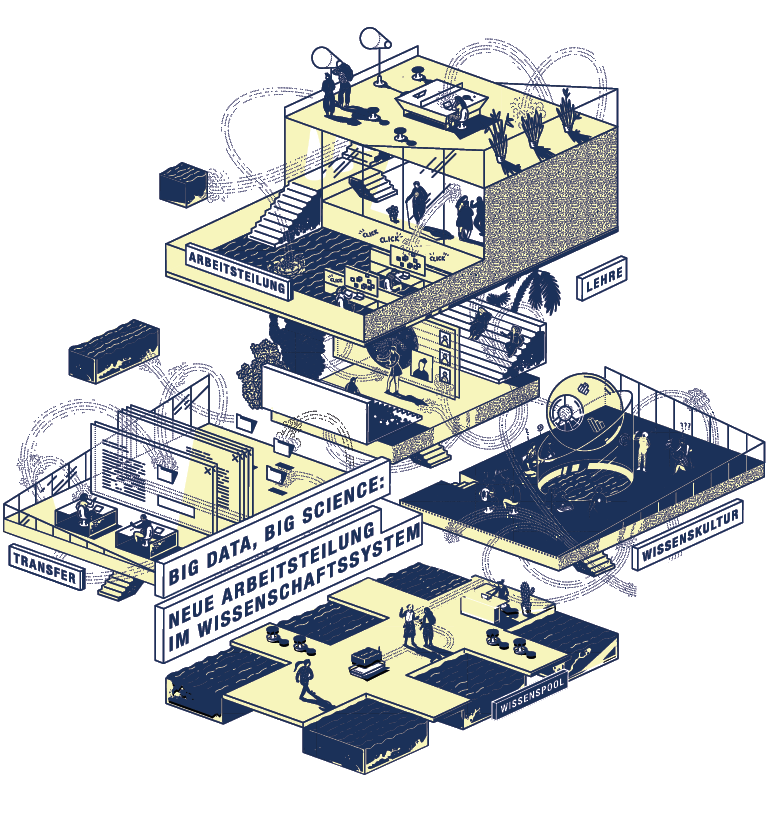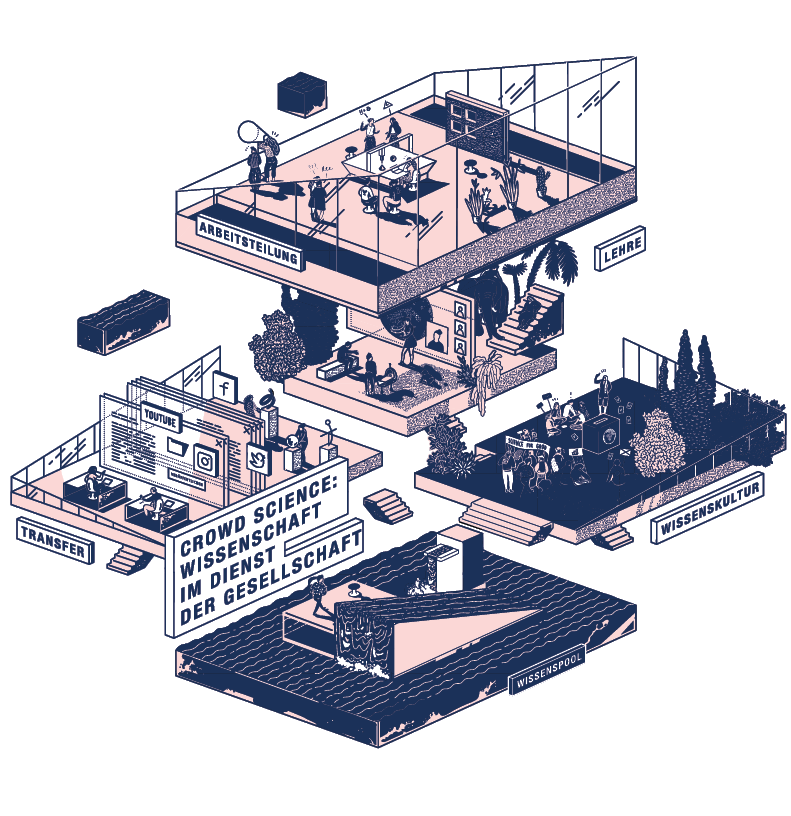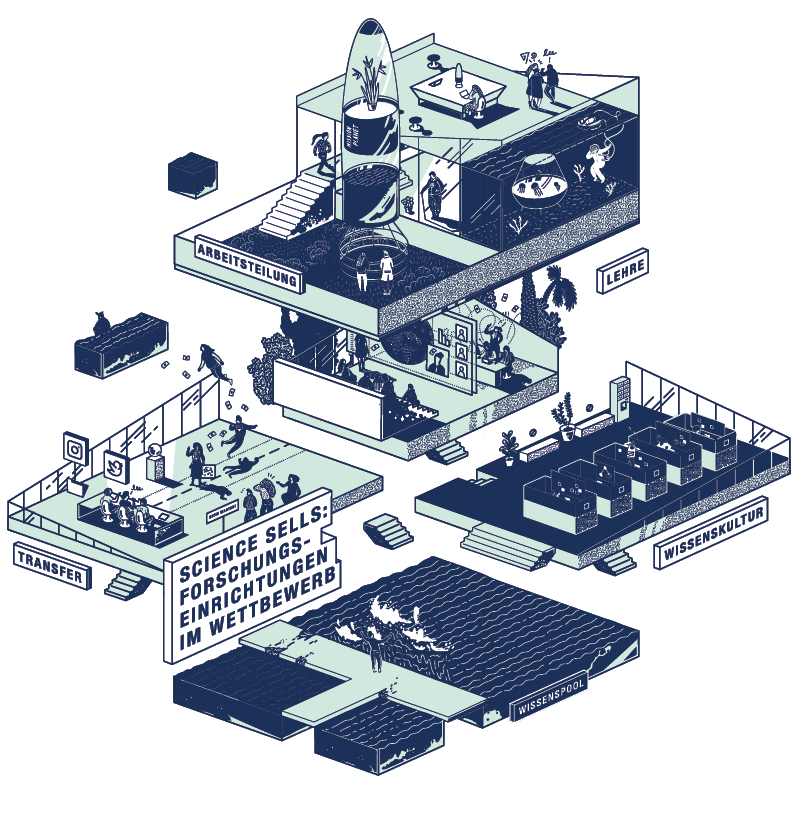The Future of Transfer 2030+
Three Speculative Scenarios for the Future of Knowledge and Technology Transfer
September 2020
Summary
Given the challenges of the present, the need for innovative approaches to solutions in production, organization, and services is greater than ever. Innovations shape the future!
Which future is conceivable, which is desirable, which is feasible – and how do we achieve it?
These questions help to identify and discuss options for the further development of knowledge and technology transfer. In order to make possible futures as accessible as possible, the team engaged foresight methods to develop speculative future scenarios. The scenarios function as a kind of lens that that provides a view of current developments and makes it possible to compare the desirability of different futures, and to align policy measures accordingly.
Methodology
The scenarios are based on trends identified in scholarly and gray literature on the future of transfer. This enabled the team to identify sub-trends in addition to megatrends, such as globalization and sustainability. Visual tools were used to help the team translate the trends identified into clusters. Our team added exploratory, speculative, and transformative elements, and expanded the scenarios in collaboration with experts and practitioners.
This approach produced three speculative scenarios that act as a basis for discussion on the function, challenges, and trajectories for the development of knowledge and technology transfer. The scenarios provide speculative statements, combining exploratory and transformative aspects, and projecting them forward to 2030 and beyond. Each scenario is homogeneous in itself and outlines a possible future; and its design distinguishes it in many heterogeneous ways from alternative possible scenarios.
Outcome: Three Scenarios at a Glance
Our team compiled a brochure that outlines the research methodology and all three scenarios in the form of narratives and illustrations. The texts present the highlights and key elements of each scenario, while the detailed descriptions give an in-depth look at possible dynamics.
You can download the brochure for free here. The accompanying audio descriptions of the three scenarios were produced by Mai Horlemann.

Scenario 1: Big Data, Big Science – New Division of Labor in the Academic System
Bit by bit to an ocean of data: political regulations demand the provision of data from everyone. Data protectors are very critical of this development. Every day, a gigantic pool of freely accessible, scientifically exploitable data is created. They are freely available via digital libraries or other certified platforms.
The number of researchers and research outcomes is exploding: the new openness of data allows anyone with the right skill set to do research, regardless of their institutional affiliation. With this data mobility, the research process can be divided into independent steps – from data collection to data analysis and visualization. Specialized science agencies and freelancers are in high demand.
Research results generated in this way are published open access. The entire academic community is involved in quality control. Citation records and awards from established institutions are considered the highest honors.
The search for possible applications is no longer the task of researchers. Instead, the use of results and transfer are carried out by third parties in accordance with the pull principle. Governmental, private sector, and civil society actors select relevant research results on open access platforms according to their needs and objectives. They are supported by a smart matching mechanism.
Increased networking and international cooperation create a global range of courses that can be accessed and used at any time. This is primarily aimed at building up data science skills. The use of data and dealing confidently with complexity are key competencies in the data society.

Scenario 2: Crowd Science – Academia in the Service of Society
Research Funding through Likes: public funding is distributed according to societal priorities and values. Funding competitions are held for flagship projects – the wider community votes on which project proposals receive funding. The social impact and benefits of research gain importance and are important evaluation criteria. Addressing societal challenges, such as climate change and poverty, becomes the main research goal, and knowledge transfer follows specific missions.
Public interest in research and its application gives science communication a new boost. Science is communicated in a captivating and engaging way by using innovative channels and formats – from 3D printing to interactive websites.
Research has left its ivory tower. Members of society become involved in research activities, and actively shape scholarship and academia. Whether generating data and knowledge or co-creating research results, living labs, real labs and prototyping workshops are part of everyday scientific work. Collaborative research practices generate new participatory processes and methods that are integrated into curricula. Cross-sectoral thinking, learning, and collaboration are strongly encouraged. The teaching of collaborative working methods and approaches to promote sustainable innovation is integrated into teaching as a cross-cutting topic.
Business, science, politics, and civil society collaborate in innovation ecosystems to implement new solutions. Since innovation processes consider diverse perspectives and needs from the outset, their results are quickly communicated, and accepted in the form of novel solutions.

Szenario 3: Science sells – Research Institutions in Competition
The law of supply and demand applies to academia, research focuses areas and topics that can be turned into profit. The academic system is entirely subject to market principles: research must be marketable and usable. The pressure to publish becomes the pressure to innovate: research findings are no longer published, but promptly turned into start-ups or patents. Numerous support services, such as company builders and innovation labs, which support start-ups on their way to the market, become more important. Return-on-investment becomes an indicator of scientific excellence and a career-defining criterion for researchers in governmental and private institutions.
Research is primarily funded by the private sector. Large companies do their own research in private instead of cooperating with established research institutions. New silos emerge, and smaller research institutions are displaced by larger institutions. Research institutions find themselves in a global competition for qualified specialists, resources, and knowledge.
The state can, to some extent, steer research by supporting certain research areas, for example, by providing expensive infrastructure, or offering subsidies and tax breaks. Alternative research projects are funded primarily by public interest or sustainability-oriented NGOs and foundations, yet those are struggling for survival in the competitive climate. As a result, basic research, and research into socially relevant areas whose results cannot be directly monetized have very limited funding options.
As promoted and demanded by companies, universities focus on the lucrative training of specialists and the teaching of market-relevant key competencies. The number of students at private training providers and universities of applied sciences grow, as their approach to training is tailored to the specific needs of companies and ensures a high level of alignment with the labor market.
Antonia Muschner
Study Lead
Fraunhofer IAO CeRRI


